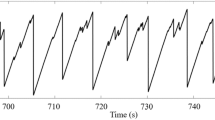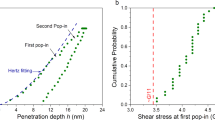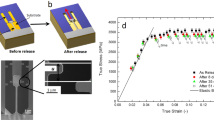Abstract
At ambient temperature the plastic flow shown by metallic glasses is localized into shear bands1,2. This localization and the liquid-like features seen on fracture surfaces are consistent with shear softening in the bands. The extent to which this softening is a result of local heating has remained controversial, with estimates of the local temperature rise ranging from less than 0.1 kelvin to a few thousand kelvin3,4,5,6,7,8,9,10,11. Here we present a new experimental method based on a fusible coating, which shows that the temperature rise, over a few nanoseconds, can be as high as a few thousand kelvin; nevertheless, the temperature rise does not seem to control the shear-band thickness. It is important to understand the mechanisms of shear banding and associated softening because these are the principal factors limiting structural applications of bulk metallic glasses, which have some attractive mechanical properties such as high yield strength12,13.
This is a preview of subscription content, access via your institution
Access options
Subscribe to this journal
Receive 12 print issues and online access
$259.00 per year
only $21.58 per issue
Buy this article
- Purchase on Springer Link
- Instant access to full article PDF
Prices may be subject to local taxes which are calculated during checkout




Similar content being viewed by others
References
Pampillo, C. A. Review: Flow and fracture in amorphous alloys. J. Mater. Sci. 10, 1194–1227 (1975).
Bengus, V. Z. et al. New features of the low temperature ductile shear failure observed in bulk amorphous alloys. J. Mater. Sci. 35, 4449–4457 (2000).
Bengus, V. Z. et al. Some peculiarities of ductile shear failure of amorphous alloy ribbons. Int. J. Rapid Solid. 8, 21–31 (1993).
Bruck, H. A., Rosakis, A. J. & Johnson, W. L. The dynamic compressive behavior of beryllium bearing bulk metallic glasses. J. Mater. Res. 11, 503–511 (1996).
Liu, C. T. et al. Test environments and mechanical properties of Zr-base bulk amorphous alloys. Metall. Mater. Trans. A 29, 1811–1820 (1998).
Flores, K. M. & Dauskardt, R. H. Local heating associated with crack tip plasticity in Zr-Ti-Ni-Cu-Be bulk amorphous metals. J. Mater. Res. 14, 638–643 (1999).
Gilbert, C. J. et al. Light emission during fracture of a Zr-Ti-Ni-Cu-Be bulk metallic glass. Appl. Phys. Lett. 74, 3809–3811 (1999).
Wright, W. J., Schwarz, R. B. & Nix, W. D. Localized heating during serrated plastic flow in bulk metallic glasses. Mater. Sci. Eng. A 319–321, 229–232 (2001).
Kim, J.-J., Choi, Y., Suresh, S. & Argon, A. S. Nanocrystallization during nanoindentation of a bulk amorphous metal alloy at room temperature. Science 295, 654–657 (2002).
Yang, B. et al. In-situ thermographic observation of mechanical damage in bulk-metallic glasses during fatigue and tensile experiments. Intermetallics 12, 1265–1274 (2004).
Yang, B. et al. Dynamic evolution of nanoscale shear bands in a bulk-metallic glass. Appl. Phys. Lett. 86, 141904 (2005).
Johnson, W. L. Bulk glass-forming metallic alloys: science and technology. Mater. Res. Soc. Bull. 24, 42–56 (1999).
Inoue, A. Stabilization of metallic supercooled liquid and bulk amorphous alloys. Acta Mater. 48, 279–306 (2000).
Li, J. C. M. Behavior and properties of shear bands. Polym. Eng. Sci. 24, 750–760 (1984).
Xue, Q., Meyers, M. A. & Nesterenko, V. F. Self-organization of shear bands in titanium and Ti-6Al-4V alloy. Acta Mater. 50, 575–596 (2002).
Donovan, P. E. & Stobbs, W. M. The structure of shear bands in metallic glasses. Acta Metall. 29, 1419–1436 (1981).
Pekarskaya, E., Kim, C. P. & Johnson, W. L. In situ transmission electron microscopy studies of shear bands in a bulk metallic glass based composite. J. Mater. Res. 16, 2513–2518 (2001).
Polk, D. E. & Turnbull, D. Flow of melt and glass forms of metallic alloys. Acta Metall. 20, 493–498 (1972).
Spaepen, F. & Turnbull, D. A mechanism for the flow and fracture of metallic glasses. Scripta Metall. 8, 563–568 (1974).
Spaepen, F. A microscopic mechanism for steady state inhomogeneous flow in metallic glasses. Acta Metall. 25, 407–415 (1977).
Steif, P. S., Spaepen, F. & Hutchinson, J. W. Strain localization in amorphous metals. Acta Metall. 30, 447–455 (1982).
Pampillo, C. A. Localized shear deformation in a glassy metal. Scripta Metall. 6, 915–918 (1972).
Krishnanand, K. D. & Cahn, R. W. Recovery from plastic deformation in a Ni/Nb alloy glass. Scripta Metall. 9, 1259–1261 (1975).
Leamy, H. J., Chen, H. S. & Wang, T. T. Plastic flow and fracture of metallic glass. Metall. Trans. 3, 699–708 (1972).
Lowhaphandu, P. & Lewandowski, J. J. Fracture toughness and notched toughness of bulk amorphous alloy: Zr-Ti-Ni-Cu-Be. Scripta Mater. 38, 1811–1817 (1998).
Hufnagel, T. C., Jiao, T., Li, Y., Xing, L.-Q. & Ramesh, K. T. Deformation and failure of Zr57Ti5Cu20Ni8Al10 bulk metallic glass under quasi-static and dynamic compression. J. Mater. Res. 17, 1441–1445 (2002).
Wang, W. H., Dong, C. & Shek, C. H. Bulk metallic glasses. Mater. Sci. Eng. R 44, 45–89 (2004).
Yamasaki, M., Kagao, S. & Kawamura, Y. Thermal diffusivity and conductivity of supercooled liquid in Zr41Ti14Cu12Ni10Be23 metallic glass. Appl. Phys. Lett. 84, 4654–4655 (2004).
Eshelby, J. D. & Pratt, P. L. Note on the heating effect of moving dislocations. Acta Metall. 4, 560–562 (1956).
Chen, H., He, Y., Shiflet, G. J. & Poon, S. J. Deformation-induced nanocrystal formation in shear bands of amorphous alloys. Nature 367, 541–543 (1994).
Jiang, W. H. & Atzmon, M. The effect of compression and tension on shear-band structure and nanocrystallization in amorphous Al90Fe5Gd5: a high-resolution transmission electron microscopy study. Acta Mater. 51, 4095–4105 (2003).
Sergueeva, A. V. et al. Shear band formation and ductility in bulk metallic glass. Phil. Mag. 85, 2671–2687 (2005).
Acknowledgements
N. Stelmashenko is thanked for assistance with sputter deposition, and M. J. Stowell for useful discussions. Experimental support for J.J.L. on sabbatical at the University of Cambridge was provided by the Office of Naval Research, DARPA and Reference Metals. Approved for public release. Distribution unlimited. A.L.G. acknowledges support from the European Commission RTN ‘Ductilisation of BMG’.
Author information
Authors and Affiliations
Corresponding author
Ethics declarations
Competing interests
The authors declare no competing financial interests.
Rights and permissions
About this article
Cite this article
Lewandowski, J., Greer, A. Temperature rise at shear bands in metallic glasses. Nature Mater 5, 15–18 (2006). https://doi.org/10.1038/nmat1536
Received:
Accepted:
Published:
Issue Date:
DOI: https://doi.org/10.1038/nmat1536
This article is cited by
-
Preparation, Microstructure, and Mechanical Properties of Bulk Metallic Glass Composite Containing In Situ-Formed Dendrites and Ex Situ Tungsten Particles
Journal of Materials Engineering and Performance (2024)
-
Increased ductility of Ni-based metallic glass ribbon pre-annealed at β-relaxation temperature
Journal of Materials Science (2023)
-
The anelastic origin of mechanical cycling induced rejuvenation in the metallic glass
Science China Physics, Mechanics & Astronomy (2023)
-
Nanosecond laser polishing of laser nitrided Zr-based metallic glass surface
The International Journal of Advanced Manufacturing Technology (2022)
-
Research on Bulk-metallic Glasses and High-entropy Alloys in Peter K. Liaw’s Group and with His Colleagues
Metallurgical and Materials Transactions A (2021)



